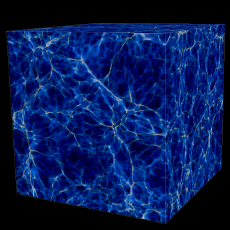UV Background
TREECOOL Tables
It is still standard in multiple hydrodynamical simulations that model the Intergalactic Medium and/or galaxy formation to account for radiative feedback via a spatially uniform, but time-varying ultraviolet background (UVB) radiation field, input to the code as a list of photoionization and photoheating rates that vary with redshift (e.g. Katz et al. 1996). For historical reasons the ascii table containing these rates that is provided to the code is usually called TREECOOL. These models are obtained using one-dimensional cosmological radiative transfer calculations. Below I list some of the more popular ones and where you can download the files:
- - Puchwein et al. (2019): You can download the UVB TREECOOL file here (check ancillary files section).
- - Khaire et al. (2019): You can download the UVB TREECOOL file here.
- - Haardt & Madau (2012): You can download the UVB TREECOOL file of this model here. Older models from this same group are also still widely used usually referred as Haardt & Madau (2006), Haardt & Madau (2001).
- - Faucher Giguere et al. (2020): You can download the UVB TREECOOL file of this model here. An older model from this same group is also still widely used usually refereed as FG09 (version updated December 2011). This model is based on Faucher Giguere et al. (2009) and can be downloaded from the same link above.
The approximate ionization and thermal histories obtained using most of these models in ΛCDM hydrodynamical simulations, including the older versions, can be found in Figures 9 and 12 of this paper.
However, in order to fully explore the parameter space of ionization, and most specially, thermal histories in a consistent way in Onorbe et al. (2017), we created a new phenomenological method to develop UVB tables that will reliable produce different ionization and thermal histories during reionization. We provide here the tables for a list of UVB models that have been constructed using this methodology and that have already been used in several scientific papers.
- Timing of HI reionization with standard heat injection: An early reionization model in which reionization finishes at z=9.70 [txt], a middle reionization model in which reionization finishes at z=8.30 [txt], and a late reionization model in which reionization finishes at z=6.55 [txt)]. These models were presented in Oñorbe et al. 2017 where you can find their exact ionization and thermal histories.
- A late and cold HI reionization history. In this model the reionization finishes at z=6.55 and it also injects a low amount of energy [txt)]. This model was used in Garzilli et al. (2019) in order to minimize the pressure effects in the intergalactic medium after HI reionization.
- More coming soon
We can provide a UVB model upon request. However you can also download the python code used to generate these models [.py]. With this code you can generate new models if you want to. Please do not hesitate to contact us if you have any questions.
Caveats and warnings:
- The UVB models presented here surely break down during reionization events as they assumed an homogeneous evolution during an intrinsically inhomogeneous process. Therefore the validity of using them in optically thin simulations (during reionization) has several limitations. We refer the reader to Oñorbe et al. (2017) and Puchwein et al. (2018) for a more detailed discussion in this regard.
- Metal ionization and cooling: The UVB models provided here only have information about the photoionization and photoheating of H and He elements (so HI, HeI and HeII). Therefore these models do not provide any information about the photoionization of any metals or their photoheating. Also, the cooling associated with H and He as well as any other element has to be implemented independly in your code. Some codes used a look up table that provides the net cooling/heating of a resolution element as a function of its density, temperature, metal content, etc. Therefore in this approach the UVB heating is combined with the specific cooling. Contact us if you are interested in running a model that uses this format.
- Mean flux: the HI, HeI and HeII photoionization in all the models provided here have been adjusted to match the HI and HeI mean flux observations. However the exact mean flux values obtained in a simulation will slightly vary depending on the exact cosmological paramaters used and the thermal state of the IGM (e.g. the specific heating/cooling processes considered). See Oñorbe et al. (2017) for more details about this.
